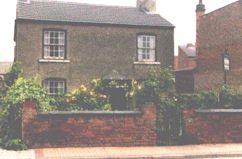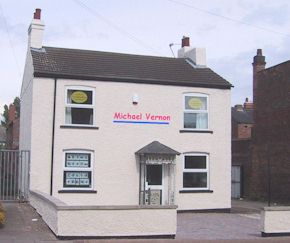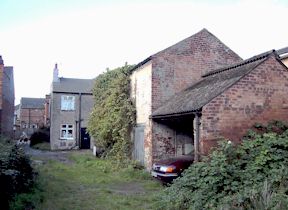


|
The Forge -
 For over 165 years, Beeston smithy has stood on the east side of what is now
Wollaton Road a short distance north of the High Road. It is a few years now since it was worked
but many remember the building with some affection - an early 19th century cottage with a walled
garden in front, a decorative wooden porch and a wrought iron sign advertising the services of the
blacksmiths who carried out their trade in the forge building in the yard at the rear.
For over 165 years, Beeston smithy has stood on the east side of what is now
Wollaton Road a short distance north of the High Road. It is a few years now since it was worked
but many remember the building with some affection - an early 19th century cottage with a walled
garden in front, a decorative wooden porch and a wrought iron sign advertising the services of the
blacksmiths who carried out their trade in the forge building in the yard at the rear.
Possibly as early as 1826 and certainly before 1840, William Dix established a blacksmith's forge at Wollaton Road - then
known as Butchers Lane - in Beeston. He and his wife Isabella had settled in Beeston from his native Staffordshire
and it was in that first year that the eldest of their 11 children was born. Isabella was the daughter of William Day, a
framework knitter who, in 1787 had acquired property on Market Street (now Middle Street) in Beeston and had developed the
site and its buildings to include what became the White Lion public house. Originally, William's son Samuel had operated
a butcher's shop on this site but this appears to have been converted to a blacksmith's shop around the time of William and
Isabella's marriage. It seems likely therefore, that William first operated from Market Street before moving to the Butchers
Lane cottage and smithy, possibly newly built, within about ten years.
The Butchers Lane location would have been ideal for a smithy as, in addition to the passing horse-drawn vehicles, there would be work to be done for the many
lace factories which surrounded the workshop and the silk mill at the junction of the Turnpike (now High Road) and Brown Lane (now Station Road). For over 50 years,
William provided for these needs from this and the earlier site, employing others to assist and training generations of apprentices over the years.
Despite their eleven children - eight of them sons - none stayed longer than a year or two in the business.
Click here to learn more about their family.. As a result, when by the late 1870s,
William's health had deteriorated - he being by then over 80 - most of his family were settled into other occupations.
It was decided that it was time to sell-up and for William to take retirement and the couple moved, with their
youngest son Samuel, to Chapel Street. Here, in poor health, they lived out the last years of their life until
William died, aged 83, in December 1881 followed 12 days later by his wife Isabella.
Following William's retirement, the business was acquired by John Wood, one of the sons of John Wood, a Leicestershire
blacksmith, and his wife Mary. The younger John had been born in East Leake in 1850 and now settled
in Beeston at the Wollaton Road location with his wife Mary and continued to provide for the shoeing
and smithing needs of the fast growing village - a valuable service that was continued after John's
death in 1910 by two of his five sons - Albert and Frederick - and, after Fred died in 1954, by Horace,
his son.
 In continuous use as a smithy for at least 165 years with only two family owners, the business had served Beeston
well but, with the death in the late 1990s of Horace Wood, the last blacksmith to operate there, the cottage and
forge began to fall into disrepair and there were many who feared that another link with old Beeston
would vanish. Happily though, in 2002 the cottage was sympathetically restored as the base for a local estate
agency - while the garden had to go, the cottage with restored porch and sign remain, certainly enough
to recall those earlier days. Now, while the ring of the telephone has replaced the ring of the anvil and customers
no longer arrive by horse and cart, the cottage building happily lives to serve another age.
In continuous use as a smithy for at least 165 years with only two family owners, the business had served Beeston
well but, with the death in the late 1990s of Horace Wood, the last blacksmith to operate there, the cottage and
forge began to fall into disrepair and there were many who feared that another link with old Beeston
would vanish. Happily though, in 2002 the cottage was sympathetically restored as the base for a local estate
agency - while the garden had to go, the cottage with restored porch and sign remain, certainly enough
to recall those earlier days. Now, while the ring of the telephone has replaced the ring of the anvil and customers
no longer arrive by horse and cart, the cottage building happily lives to serve another age.
 Hopes for a future for the smithy building itself, at the rear (seen here in December 2000 but since deteriorated
further) have been raised several times since the building was last used but none has so far not come to anything. In
recent years, several of the old features have been removed, including the turntable used to turn carts in the yard
so that they could more easily negotiate the narrow drive onto Wollaton Road. Now, all that remains is a
a sad building, boarded-up, much vandalised and forgotten at the rear of the cottage by most passers-by and one wonders if
it too can survive in a new use - let us hope so.
Hopes for a future for the smithy building itself, at the rear (seen here in December 2000 but since deteriorated
further) have been raised several times since the building was last used but none has so far not come to anything. In
recent years, several of the old features have been removed, including the turntable used to turn carts in the yard
so that they could more easily negotiate the narrow drive onto Wollaton Road. Now, all that remains is a
a sad building, boarded-up, much vandalised and forgotten at the rear of the cottage by most passers-by and one wonders if
it too can survive in a new use - let us hope so.

© David Hallam - 2005
|
 |
 In continuous use as a smithy for at least 165 years with only two family owners, the business had served Beeston
well but, with the death in the late 1990s of Horace Wood, the last blacksmith to operate there, the cottage and
forge began to fall into disrepair and there were many who feared that another link with old Beeston
would vanish. Happily though, in 2002 the cottage was sympathetically restored as the base for a local estate
agency - while the garden had to go, the cottage with restored porch and sign remain, certainly enough
to recall those earlier days. Now, while the ring of the telephone has replaced the ring of the anvil and customers
no longer arrive by horse and cart, the cottage building happily lives to serve another age.
In continuous use as a smithy for at least 165 years with only two family owners, the business had served Beeston
well but, with the death in the late 1990s of Horace Wood, the last blacksmith to operate there, the cottage and
forge began to fall into disrepair and there were many who feared that another link with old Beeston
would vanish. Happily though, in 2002 the cottage was sympathetically restored as the base for a local estate
agency - while the garden had to go, the cottage with restored porch and sign remain, certainly enough
to recall those earlier days. Now, while the ring of the telephone has replaced the ring of the anvil and customers
no longer arrive by horse and cart, the cottage building happily lives to serve another age. Hopes for a future for the smithy building itself, at the rear (seen here in December 2000 but since deteriorated
further) have been raised several times since the building was last used but none has so far not come to anything. In
recent years, several of the old features have been removed, including the turntable used to turn carts in the yard
so that they could more easily negotiate the narrow drive onto Wollaton Road. Now, all that remains is a
a sad building, boarded-up, much vandalised and forgotten at the rear of the cottage by most passers-by and one wonders if
it too can survive in a new use - let us hope so.
Hopes for a future for the smithy building itself, at the rear (seen here in December 2000 but since deteriorated
further) have been raised several times since the building was last used but none has so far not come to anything. In
recent years, several of the old features have been removed, including the turntable used to turn carts in the yard
so that they could more easily negotiate the narrow drive onto Wollaton Road. Now, all that remains is a
a sad building, boarded-up, much vandalised and forgotten at the rear of the cottage by most passers-by and one wonders if
it too can survive in a new use - let us hope so.
 For over 165 years, Beeston smithy has stood on the east side of what is now
Wollaton Road a short distance north of the High Road. It is a few years now since it was worked
but many remember the building with some affection - an early 19th century cottage with a walled
garden in front, a decorative wooden porch and a wrought iron sign advertising the services of the
blacksmiths who carried out their trade in the forge building in the yard at the rear.
For over 165 years, Beeston smithy has stood on the east side of what is now
Wollaton Road a short distance north of the High Road. It is a few years now since it was worked
but many remember the building with some affection - an early 19th century cottage with a walled
garden in front, a decorative wooden porch and a wrought iron sign advertising the services of the
blacksmiths who carried out their trade in the forge building in the yard at the rear.